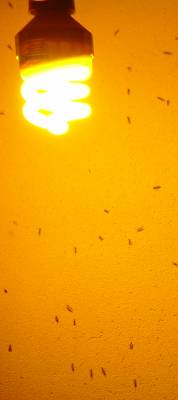 I noticed this interesting effect tonight. This “insect-repellent” CF luminaire doesn't attract insects — but light reflected from it by the wall behind does. If you look at the image, you can see that the wall has plenty of insects (in reality, about a quarter the density that a standard “warm white” would attract), but none circling the fitting (the standard fitting has dozens circling it constantly).
I noticed this interesting effect tonight. This “insect-repellent” CF luminaire doesn't attract insects — but light reflected from it by the wall behind does. If you look at the image, you can see that the wall has plenty of insects (in reality, about a quarter the density that a standard “warm white” would attract), but none circling the fitting (the standard fitting has dozens circling it constantly).
I wonder if, with a bit of chemical cunning, a paint could be devised which reflected strongly in those wavelengths regarded by insects as uninsteresting or even repellent? The result would be an insect-repellent surface. Not useful for keeping your windscreen clean, but if it halved the number of mozzies trying to batter their way through your flywire it might be helpful.
Comments